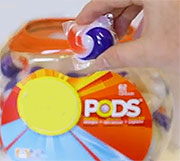
THURSDAY, July 16, 2015 (HealthDay News) — Consumer Reports said Thursday that it has removed liquid laundry pods from its “recommended” list because of the dangers they pose to small children.
The nonprofit organization, which rates a wide variety of consumer products for safety and reliability, also urged that the convenient laundry aids be avoided altogether in homes where children younger than 6 years of age live or ever visit.
In most injury cases, children try to bite or poke through the pods, and the highly concentrated detergent gets into their eyes or goes down their throats. Once ingested, vomiting and coughing are common, but comas, seizures and breathing problems can occur in rare cases, the nonprofit said.
“Since single-load laundry detergent pods hit the mainstream market in early 2012, two things have become clear: The product is a convenient, often effective way to do the laundry — and it’s a serious health hazard for young children,” Consumer Reports said in a statement.
“We recognize the role parents and caregivers play in keeping children safe, but we believe the unique risks posed by liquid laundry pods warrant this action,” the group added. The action did not include laundry or dishwasher pods that contain powder, since there have been far fewer reports of harm with those products.
For the first six months of 2015, poison control centers nationwide received more than 6,000 reports of kids aged 5 and younger ingesting or inhaling pods, or getting pod contents on their skin or in their eyes, Consumer Reports said. That’s a pace that’s set to surpass last year’s total of 11,714. Since 2013, two children have died, the group added.
Past research has already shown the pods are dangerous. A 2014 report found they seriously sickened more than 700 U.S. children during a two-year period.
Poison control centers across the country logged more than 17,000 calls about children exposed to the pods during that same period.
“Something about these pods makes them highly toxic. They pose a very serious poisoning threat to kids,” report co-author Dr. Gary Smith, director of the Center for Injury Research and Policy at Nationwide Children’s Hospital in Columbus, Ohio, told HealthDay.
“Parents need to make an informed decision if they bring these products into their homes,” Smith added. “We’re recommending that they not use these pods if they have young children in the home.”
Young children “are curious, and they have no concept of danger,” he said. “They explore their environment by putting things in their mouth, and they see something that’s colorful and can easily mistake it for candy or juice.”
Dr. Jeanie Jaramillo, managing director of the Texas Panhandle Poison Center, agreed. “They [pods] are also soft and pliable, so kids may find that they are fun to squeeze or play with,” she added.
But when kids bite into a liquid laundry detergent pod, “they get this big squirt of concentrated chemicals, a large amount of fluid,” Smith said.
“It’s a relatively new phenomenon. We’ve seen children coming into our hospital emergency department with really severe consequences of ingesting contents from these detergent pods,” Smith added.
In the 2014 report, children under 3 accounted for about three-quarters of cases and 8 percent had what the researchers called a moderate or major medical issue as a result.
More than 700 children required hospital admission, often to an intensive care unit, Smith said. “In many cases, they were in a coma,” he added.
More than 100 children needed to be intubated — to have a tube put down their throats to help them breathe.
Smith said he hasn’t seen any reports that explain what makes the laundry pods so toxic.
Pod manufacturers have responded to concerns by putting latches on pod containers and making them opaque so kids can’t see inside them. But Smith said more needs to be done to make the containers truly child-resistant and to provide proper warning labels.
More information
For more about the safety of laundry detergent pods, see the American Association of Poison Control Centers.
Copyright © 2025 HealthDay. All rights reserved.

